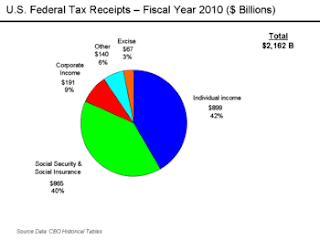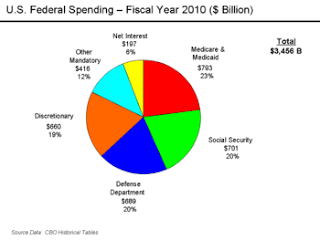I favor simplicity and clarity, so lawyers and tax accountants who make their living through tax law ambiguity are not going to like my proposals.
We can consider six general sources of Federal government revenue: personal income taxes, corporate income taxes, taxes on sales (or components of sales price, like value-added-taxes), wealth taxes, fees and social insurance payroll taxes.
Personal Income Taxes
Here is my simplified income-tax form:
Line 1: Income from all sources
Line 2: Expenses directly related to generating income
Line 3: Net income [Line 1 – Line 2]
Line 4: Tax on Line 3.
Schedule A lists all sources and amounts of income.
Schedule B lists all expenses directly related to generating income.
That’s it. All individuals must use a cash basis of accounting. If you don’t have a personal business, line 2 is zero. There are no deductions for mortgage interest, property taxes, state income taxes, state or local sales taxes, charitable contributions, medical expenses, IRAs. None. How you spend your money is immaterial to the income tax you pay.
The tax would be graduated (the rates dependent upon the amount of revenue needed). The minimum rate is 1%. If you only earn $8 an hour and work 1,000 hours a year because the economy sucks, you’ll still pay $80 in income tax. If government needs to support you, that’s an expenditure and shows up on the other side of the ledger.
There are no lower rates for capital gains or dividends. If you suffer capital losses, they offset income only to the extent you do not have unrealized capital gains on other assets. [To be honest, I’d rather mark all assets to market and tax the net increase in unrealized appreciation, but I doubt that would fly for individuals.]
I would allow a five-year transition to ease into the new system (and help the tax accountants and attorneys transition to useful employment). In year one, each of us pays the lesser of the new tax or the sum of 20% of the new tax and 80% of the old. In year two the percentages change to 40% and 60%. In five years the transition is complete. If in any year the new tax is less than the old tax, you are done with your personal transition.
Business Income Taxes
Line 1: Income from all sources
Line 2: Expenses directly related to generating income
Line 3: Net income [Line 1 – Line 2]
Line 4: Tax on Line 3.
Schedule A lists all sources and amounts of income.
Schedule B lists all expenses directly related to generating income.
That’s it. Corporations must also use a cash basis of accounting. Business expenses include bond interest and dividends (since both are taxable to the individuals to whom they are paid). Business expenses do not include charitable contributions, political contributions or any other payments that are not counted as income by a taxable entity. For example, if a gift to an employee isn’t taxable to the employee, it’s not deductible by the corporation.
Yes, I do understand that cash accounting will allow corporations to delay recognition of income to the next accounting period and speed up payment of expenses, but that is offset by other corporations attempting to do the same things.
I recognize that because of parent/subsidiary purchases and sales and foreign corporations that there is a gaping hole in this simplified version. We can solve the subsidiary problem by requiring corporate taxes only at the parent level. For multinational corporations, the rules will necessarily be more complicated and not all tax attorneys and accountants will be out of their jobs. Oh well.
Unlike for individuals, I do not see the necessity of a graduated corporate income tax. The rate should be high enough to reflect that corporations benefit from the government’s existence, but generally should be lower than the upper brackets of individual taxpayers. I’ll offer them the same kind of five-year transition that individuals received.
Sales Taxes & VATs
Although sales and VAT taxes are regressive (those with lower incomes, who must spend all or most of their income each year, pay a disproportionate share of their income on these taxes), I think they have a place in generating government revenue.
Politicians favor them because once approved, individuals perceive them as less objectionable than income taxes since we pay them in little bits and pieces and the total is not as visible as the annual income tax.
Because the government monitors product safety, regulates interstate exchange, etc. I favor a sales-type tax to allow some direct recognition of those Federal government expenses on our behalf. As with the minimal level of individual income tax, if the effect of a Federal sales tax is to take bread out of the mouths of babes, there are other ways to replace the bread.
Wealth Taxes and their kin
Wealth taxes come in two forms: Real estate property taxes are the form most people think of, although strictly speaking that is not a wealth tax since the property owner is taxed on the value of the property, not on the his financial stake in the property. It doesn’t matter whether you own the property or whether you and the bank own the property (or even if the property value is underwater and is worth less than the mortgage), the real estate tax is the same. Real estate taxes are most often local or regional in nature.
Many states use a form of wealth tax as a substitute or auxiliary to income taxes. The tax applies to certain kinds of property: automobiles, boats, stocks and bonds, to name a few.
The second general form of wealth tax is an estate tax. Besides generating income, estate taxes (what Republicans call a “death tax”) also serve the social purpose of redistributing “excess” accumulated wealth to avoid producing a financial aristocracy. Although I personally think that is a good reason for estate taxes, I’ll leave that discussion to the citizen panel I “drafted” in the previous blog.
The other purpose of the estate tax is to capture any deferred income tax—and this is undeniably fair. By not taxing the unrealized appreciation in assets until the assets are sold, it allows individuals to defer income. Death may or may not result in a final reckoning with St. Peter at the Pearly Gates depending on your religious beliefs, but it should result in a final reckoning of your income taxes.
To the extent you have not paid income taxes on any unrealized appreciation, those deferred taxes should be paid in the year of your death. It is a misnomer to call this a death tax; it is actually a deferred income tax. It should apply to anything that has appreciated in value, not just stocks and bonds. That includes the family house or farm or family business. Again, how you choose to spend your money is not the government’s business, but if you invest it in anything and the investment earns money, Uncle Sam should get his cut.
Fees
Fees are likely the smallest source of revenue, but not insignificant. If the law requires us to use a government service, there should be no fee. If we choose to use the service for our convenience and receive some benefit from that service, then a fee is appropriate.
For example, I am required to file an income tax. I should not be charged a fee to do so. I am not required to visit Canada, however if I choose to do so, I will need to get a passport. I should pay for the cost of the passport. Yes, I understand that will bar many citizens from leaving the country. Poverty has many prices and this is one of them. We require everyone to have a Social Security card and all males (why not females?) to register for the draft—no fees attached.
Fees make sense as a way for drug companies to pay for testing their products before releasing them to the general public. Similarly when I wanted to be certified as an Enrolled Actuary, I needed to pass a test jointly administered by the IRS and DOL. I should pay for that as well as the periodic costs of documenting that I had met the continuing education requirements.
Social Insurance Payroll Taxes
I put FICA taxes last for a reason. Because they are inextricably linked to Social Security and Medicare benefits, the amount of these taxes must be addressed at the same time the long-term design of Social Security and Medicare are determined.
And that dear reader will be the subject of my next blog.
~ Jim





















